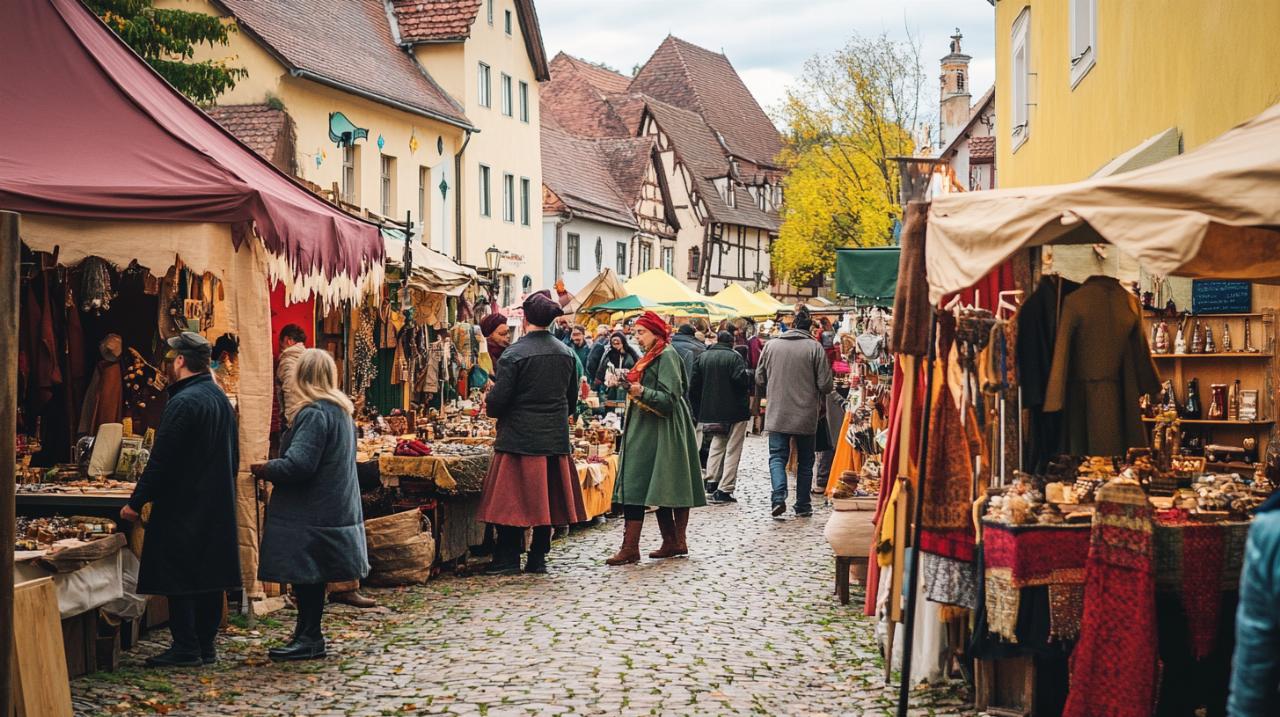There’s something genuinely captivating about wandering through a bustling European square as the air fills with the scent of roasted chestnuts and the sound of traditional music drifting from nearby stalls. Across the continent, seasonal festivals and vibrant markets provide a gateway into the heart of local traditions, offering travellers a chance to experience craft markets and cultural heritage in ways that guidebooks simply cannot capture. These gatherings, whether beneath the glow of Christmas lights or amidst the fresh blooms of spring, reveal the living pulse of communities that have celebrated their customs for centuries.
The Timeless Allure of European Craft Markets Throughout the Seasons
European markets have long served as vital community hubs, spaces where artisans, farmers, and traders converge to share their wares and stories. From the cobbled streets of Krakow to the grand plazas of Barcelona, these markets reflect the rhythms of the seasons and the distinct character of their regions. The tradition of gathering in public squares to buy, sell, and celebrate stretches back centuries is deeply rooted in craft markets and cultural heritage. And today’s markets continue to honour that legacy whilst adapting to modern tastes and sustainability concerns. Markets such as La Boqueria in Barcelona and Portobello Road Market in London have become renowned not just for their goods but for the atmosphere they create, blending the old with the new in ways that feel both authentic and welcoming.
Traditional artisan crafts that define continental heritage
The true heart of these markets lies in the craftsmanship on display. Across Europe, traditional artisan crafts remain central to regional identity, with local vendors offering handmade gifts, woollen textiles, and intricately carved wooden figurines that speak to centuries-old techniques passed down through generations. In Poland, visitors to the Christmas market in Krakow’s Main Square can find Polish handicrafts and grilled oscypek, a smoked cheese that embodies the culinary traditions of the Tatra Mountains. Meanwhile, in the medieval towns of Spain, festivals such as the Bodas de Isabel de Segura celebrate historical reenactments and showcase crafts that harken back to the Middle Ages. These artisan products are more than souvenirs; they are tangible connections to the folklore and cultural heritage that define each community.
Farmers markets, flea markets, and specialty markets further enrich the landscape, offering everything from vintage treasures to locally sourced products. The Naschmarkt in Vienna, for instance, combines international flavours with local delicacies and, on Saturdays, transforms into a haven for collectors seeking antique finds. The Mercado de Sant’Ambrogio in Florence provides a quieter, more intimate experience, where fresh produce and traditional foods reflect the rhythms of Tuscan life. Interacting with vendors, sampling regional specialties, and observing the meticulous care that goes into each handcrafted item allows travellers to appreciate the dedication and skill that sustain these traditions. Arriving early and bringing cash remain practical tips for navigating these bustling spaces, whilst respecting local etiquette and supporting local communities ensures that these markets continue to thrive.
How seasonal transitions shape market offerings and celebrations
The changing seasons bring distinct flavours and festivities to European markets, with each period offering its own unique experiences. Winter markets, particularly Christmas markets, transform town squares into glittering wonderlands adorned with festive decorations, Christmas trees, and nativity scenes. Strasbourg, known as the Capital of Christmas, hosts a market dating back to 1570, featuring over 300 wooden chalets where visitors can savour vin chaud and admire Alsatian crafts. Cologne’s Christmas markets, scattered across the city with the main gathering near Cologne Cathedral, offer traditional craftsmanship and culinary offerings that include Lebkuchen and mulled wine. In Budapest, the Advent Feast at the Basilica combines a 3D light show with Hungarian crafts and chimney cake, whilst Vienna’s markets emphasise sustainability with biodegradable packaging and locally sourced products.
Spring and autumn bring their own charms, with festivals celebrating harvest traditions, art, and historical customs. Spring is a time for Irish and Celtic celebrations, with events such as St Patrick’s Day drawing crowds eager to experience the vibrant music and folklore of the Emerald Isle. In June, the medieval festival in Hondarribia in Gipuzkoa offers a glimpse into Spain’s storied past, whilst outdoor concerts in gardens and castles provide a stage for live music and theatre shows. The Aljafería Palace in Zaragoza and the Alcázar of Seville host jazz and rock gigs, blending historic venues with contemporary performances. Autumn sees the arrival of harvest festivals and Oktoberfest, where seasonal produce and traditional recipes take centre stage. Wine harvests in regions such as Tuscany and the Rhine Valley offer opportunities to sample local wines and participate in centuries-old rituals that honour the land and its bounty.
Farmers markets in spring and autumn are particularly vibrant, showcasing fresh baguettes, cheeses, and seasonal delicacies that reflect the agricultural cycles of the continent. The Marché Bastille in Paris and the Boquería in Barcelona become focal points for food lovers, whilst guided tours and market navigation tips help visitors make the most of their time. Haggling etiquette, early arrival, and vendor interaction are all part of the experience, fostering connections that transcend mere transactions. These markets also serve as platforms for ethical shopping and charitable support, with many vendors emphasising sustainable tourism and locally sourced products.
Cultural Festivals as Windows into Europe’s Living Traditions

Beyond the stalls and street food, cultural festivals offer immersive experiences that bring history, folklore, and community to life. These events, ranging from religious festivals to modern cultural celebrations, provide a window into the values and customs that have shaped European societies. With cultural tourism growing by 15 per cent annually, incorporating festivals into travel packages has become a way for visitors to access unique experiences and authentic traditions that might otherwise remain hidden. From the Viking celebrations of Up Helly Aa in Lerwick, Shetland, to the masquerade elegance of Venice Carnival, each festival tells a story of resilience, creativity, and communal identity.
Regional festivities that preserve centuries-old customs
Regional festivities across Europe serve as living repositories of centuries-old customs, offering insights into the diverse cultures that populate the continent. In Northern Europe, Midsummer celebrations in Sweden and Finland mark the longest day of the year with traditional music, folk dances, and flower crowns, whilst Up Helly Aa in January sees Shetland Islanders honour their Norse heritage with a dramatic Viking procession and torchlit ship burning. In Southern Europe, the Battle of the Oranges in Ivrea commemorates a historical rebellion through a spirited reenactment, whilst the Palio di Siena transforms the medieval city into an arena for a historic horse race that has captivated locals and visitors for centuries.
Religious and spiritual festivals, such as Semana Santa in Seville and Easter traditions across the continent, blend solemnity with vibrant processions, showcasing the deep-rooted faith that continues to influence European life. The Kukeri festival in Bulgaria, with its elaborate costumes and ritual performances, reflects the region’s ancient pagan roots, whilst All Saints’ Day and Bonfire Night in the United Kingdom offer moments of reflection and communal celebration. These festivals are not static relics of the past; they evolve and adapt, incorporating contemporary elements whilst remaining anchored in the traditions that define them.
Historical reenactments and medieval festivals provide further opportunities to step back in time. The medieval festival in Hondarribia and similar events across Spain invite visitors to witness jousting tournaments, period crafts, and historical performances that recreate the atmosphere of bygone eras. The Viking Festival in the Lofoten Islands of Norway in August offers cultural reenactments that bring Norse sagas to life, complete with traditional music and dance performances. These events often include craft workshops where participants can learn traditional techniques, from blacksmithing to embroidery, ensuring that the skills of past generations are not forgotten.
The Role of Community Gatherings in Sustaining European Identity
Community gatherings lie at the heart of European identity, providing spaces where locals and visitors alike can come together to celebrate shared values and traditions. Markets and festivals function as more than commercial enterprises; they are social rituals that reinforce bonds, transmit cultural knowledge, and foster a sense of belonging. The importance of these gatherings extends beyond the economic benefits they bring to local vendors and tourism industries. They serve as platforms for storytelling, education, and the preservation of folklore that might otherwise fade in the face of globalisation.
Theatre shows, dance performances, and poetry readings held in cultural clubs and historic venues such as the Teatro de la Abadía in Madrid and the Teatre Nacional de Catalunya in Barcelona illustrate the ongoing commitment to the arts and humanities. Outdoor performances in parks and gardens during spring and summer months create accessible cultural experiences that draw diverse audiences, whilst international festivals offer workshops and exhibitions that highlight local crafts and contemporary art. The Edinburgh Fringe, for example, has become a global phenomenon, yet it remains rooted in the Scottish capital’s rich cultural traditions and community spirit.
Light displays, ice skating rinks, and festive shopping in winter markets create moments of joy and connection during the colder months, whilst river cruises along the Rhine, Main, and Danube offer leisurely ways to experience multiple markets and festivals in one journey. Tour operators such as Collette, Insight Vacations, Contiki, and Trafalgar provide escorted tours that facilitate festival planning and accommodation planning, ensuring that travellers can fully immerse themselves in the experiences without the stress of logistics. Advance booking remains essential for securing the best viewing spots and avoiding crowds, particularly during peak periods such as December and August.
Guided tours of museums and historic venues complement the market experience, offering deeper insights into the art and history that underpin regional traditions. Museums often host temporary exhibitions showcasing local crafts, whilst specialty markets and flea markets provide opportunities to discover antique treasures and handmade gifts that reflect the character of their locales. The Portobello Road Market in London, for instance, combines antiques, fashion, and street food in a vibrant atmosphere that captures the eclectic spirit of the city. Similarly, the Mercado de San Miguel in Madrid offers a curated selection of local delicacies and culinary offerings that highlight Spain’s rich gastronomic heritage.
As the seasons shift, so too do the themes and offerings of these gatherings. Spring celebrations such as May Day and the Córdoba Patios Festival in Spain bring forth the blooming gardens and outdoor festivals that define the season, whilst autumn festivals celebrate the harvest with seasonal produce and traditional recipes. The Alba White Truffle Festival in Italy draws food enthusiasts eager to sample one of the region’s most prized ingredients, whilst Oktoberfest in Germany remains a global symbol of Bavarian culture, complete with traditional music, hearty cuisine, and communal revelry.
The continuity of these traditions depends on the active participation of local communities and the respectful engagement of visitors. Supporting local vendors, respecting local etiquette, and embracing ethical shopping practices all contribute to the sustainability of these cultural experiences. Biodegradable packaging, locally sourced products, and charitable support initiatives reflect a growing awareness of the need to balance tourism with environmental and social responsibility. By engaging with these festivals and markets on their own terms, travellers can gain a deeper appreciation for the customs and values that have shaped Europe’s diverse cultural landscape.
Ultimately, exploring Europe’s craft markets and cultural heritage through seasonal festivals is about more than collecting souvenirs or ticking items off a travel checklist. It is an invitation to slow down, to listen, and to participate in the living traditions that continue to define the continent’s identity. Whether wandering through the wooden chalets of Strasbourg, marvelling at the light displays in Craiova, or joining in the revelry of La Mercè in Barcelona, visitors find themselves part of a story that stretches back centuries and continues to unfold with each passing season. These experiences offer a reminder that culture is not something to be observed from a distance but something to be lived, shared, and celebrated together.
